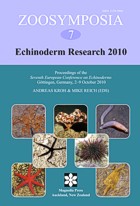Abstract
Despite the extensive use of sea urchins in embryology, the hormonal mechanisms regulating echinoid reproductive processes are scarcely known. This research is focused on the role of estradiol (E2), whose presence and seasonal variations in different echinoderm tissues have been previously reported. Three different concentrations of E2 were administered (via peristomial injection, 2/week) to adult specimens of the sea urchin Paracentrotus lividus for 2 and 12 weeks. The lowest concentration was close to physiological values, previously measured in field specimens. Despite the increase of circulating E2 in the coelomic fluids, neither short- nor long-term hormonal treatment induced marked variations in the considered reproductive parameters. The Gonad Index appeared to be more influenced by the feed intake than by E2. Similarly, the maturation stage of the gonads was not markedly affected by E2 injection, although some sex-specific differences could be observed: treated females never reached the maximum maturation stage compared to controls, although this was observed in males injected with the lowest E2 concentration. Although further research is needed to confirm our observations, according to the present study E2 does not markedly influence echinoid reproduction and, particularly, it does not promote female maturation, as reported for vertebrates and suggested for asteroid echinoderms.

